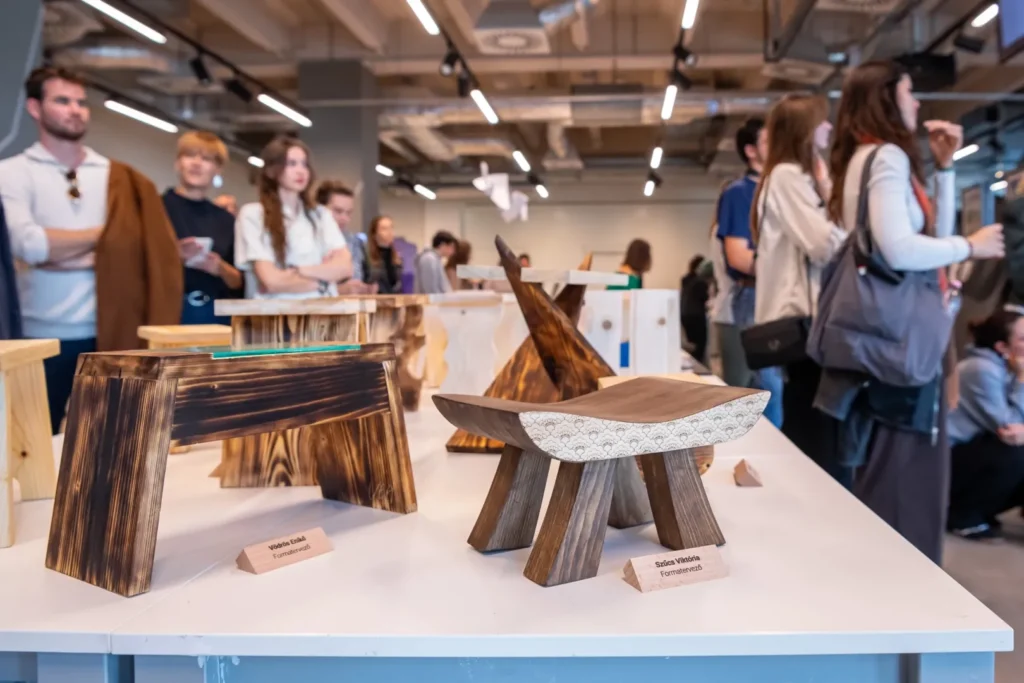Created: 2025.10.14.
For the first time this year, Széchenyi István University’s Faculty of Architecture, Civil Engineering and Transport Sciences organised its Creative Week together with the Design Week of the Faculty of Arts. The new joint initiative encouraged collaboration, teamwork, exploring new perspectives, and interdisciplinary thinking among students.
At the Faculty of Architecture, Civil Engineering and Transport Sciences (ÉÉKK), Creative Week has a decades-long tradition, providing students with practical, real-life design challenges each year. The Design Week at the University’s Design Campus serves similar aims. This autumn, the two events merged for the first time in the spirit of interdisciplinary cooperation, jointly organised by the Department of Architectural Design and the Department of History of Architecture and Town Planning from ÉÉKK, as well as the Departments of Architecture and Industrial Design from the Faculty of Design and Performance Arts. Altogether, students worked in mixed teams on twenty topics, allowing for more diverse perspectives and creative approaches.

“Our event not only provides professional knowledge and practical experience, but also strengthens personal connections and teamwork among our students. It is an important step to host the architectural Creative Week and the design students’ Course Week together under the name “Al/Ku” – a title that, beyond the original meanings, symbolises the collaboration between professionals from different fields,” said Dr János Szép, Dean of the Faculty of Architecture, Civil Engineering and Transport Sciences, at the opening of the week. He added that it is essential for the two disciplines to make use of the opportunities that can strengthen one another.
“At our department, Creative Week has a nearly twenty-year tradition, aiming to create a concentrated and inspiring working environment. Beyond their regular weekly tasks, students can delve into topics that would not normally fit into the standard curriculum, yet are highly exciting and motivating. Working alongside design students made the week even more dynamic and inspiring,” explained Dr Tamás Szentirmai, Head of the Department of Architectural Design, who first came into contact with the University over a decade ago through Creative Week, where he has since regularly participated as a course leader.

Dr Tamás Szentirmai, Head of the Department of Architectural Design, noted that the inspiring atmosphere of Győr drew him to the University (Photo: Gergely Nagy)
Gábor U. Nagy, Head of the Department of Architecture, highlighted that the joint week involved more than two hundred students – a remarkable achievement in itself. “The teams were composed of mixed groups – students of the Architecture, Design, and Industrial Design programmes working side by side. The topics were extremely diverse, ranging from installations to photo and video projects, and even site-specific artworks. The programme gave us the opportunity to better understand each other’s way of thinking and to inspire one another,” he said.

Gábor U. Nagy, Head of the Department of Architecture, underlined that the “Al/Ku” Week involved over two hundred students and fostered inspiring collaboration (Photo: Gergely Nagy)
Over the course of one week, students completed their project assignments, which were presented at an exhibition held on the final day at the University’s Innovation Park in Győr.
For the students, the collaboration offered a completely new experience. “It was a great opportunity to get to know the Architecture students better, as we had rarely worked together before. Our installation was based on the theme of transformation – we created an artwork for the studio building using recycled materials. The Architecture students worked with pipes, while we used nets, so a spontaneous contrast emerged that ultimately came together in a harmonious way,” shared second-year students of the Architecture programme, Réka Dóra Bejó and Nóra Tarjányi.
Kristóf György Nagy, a student of the Master’s in Architecture programme, took on a mentoring role during the week. “Three teams collaborated on a shared theme: one recorded the sounds of bridges, another used a digital pinhole camera to take unique photographs, while the third created an abstract cityscape using satellite imagery. We combined these into a single installation, offering a new perspective on the bridges of Győr. Al/Ku Week showed us how collaboration between different disciplines can be truly inspiring. The experience gained here will be valuable in the future too – the ‘Káptalandomb Design Competition’, open to students of both departments, provides another opportunity for joint creative work,” he emphasized.






